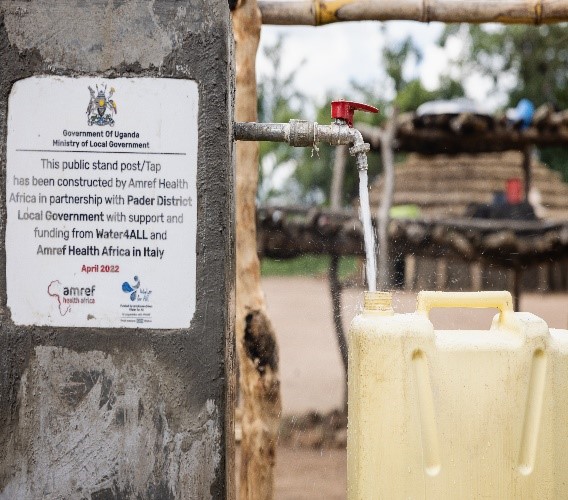Equitable access to WASH, the potential silver bullet to UHC
Tuesday, 17 January, 2023

The SDG, to which Uganda is signatory aims to achieve universal and equitable access to safe and affordable drinking water, end open defecation and provide adequate and equitable access to sanitation and hygiene for all by 2030.
However, it is 2023 and 13.8 million Ugandans still share latrines and 3.2 million (nearly a tenth of the population) still defecate in the open. Only 35.8% of Ugandans in the rural setting and 53.4% in the urban setting practice hand washing at critical times. It is no wonder that diarrhoea, a water born disease still contribute to 88% of annual diarrheal deaths and responsible for 22% of deaths of children under 5 years (33 deaths per day). Early childhood diarrhoea is not only deadly; it also contributes to Uganda’s high levels of stunting, which in turn affects children’s cognitive development and performance at school.
Limited access to WASH has further reaching consequences for the country. Ugandan government loses around 86 million (GBP) annually, because of issues including; premature death, access time, productivity losses whilst sick or accessing healthcare.
Poor people carry the greatest burden of poor sanitation. The poorest 20 percent of the population is 13.5 times more likely to defecate in the open than the wealthiest 20 percent, according to the World Bank.
This situation is even worse for women due to the fact that typically women and girls in Africa are the main provider of household water. Lack of water, sanitation and hygiene services in schools result in girls missing school because they are either travelling long distances to fetch clean water or when they reach puberty the lack of separate toilets disheartens girls to attend full time. Poor Menstrual Hygiene Management in schools contributes to a 10% drop out of girls.
Evidence shows that Universal access to safe drinking water, adequate sanitation, and hygiene has the potential to reduce the global disease burden by 10%. For a country like Uganda that has over 70% of disease burden associated with water sanitation and hygiene, sustainable access to safe drinking water, sanitation and hygiene could be the silver bullet to achieving universal health coverage and poverty eradication for the country.
However, as we think about using this silver bullet to achieve universal health coverage and eradicate poverty, we need to be mindful of the social and inherent community factors that may impede on our efforts. We need to use systems approaches planning such that planners move away for linear planning and adopt inclusive circular planning.
How WASH and Health can work together effectively
In 2016, Amref Health Africa in Uganda conducted an assessment of all the health care facilities in Amuru district. The assessment established the facts below;
- 24/24 of the sampled centers did not have running water in maternity wards.
- Midwives & pregnant mothers fetched water from over 500 meter distance.
- Only 16.7% of healthcare facilities had an improved latrine that meets the needs of people with reduced mobility.
- 24/24 of the health care facilities had no hand washing facilities near the latrines.
- 33.3% of healthcare facilities shared latrine facilities with the community (not patients).
Consequently
- Only 11.9% of the mothers and caregivers practiced hand washing.
- Only 20.8% of women deliver at health facilities (district HMIS).
- 43.5% had sepsis in the first 28 days of their lives.
Amref designed an intervention to that integrated WASH and Reproductive Maternal New borne Child, Adolescent Health (RMNCAH) to increase skilled birth attendance in order to reduce the incidence of neonatal sepsis in Amuru District (intervention in 6 HCF).
The 6 targeted HCF facilities that were conducting deliveries at that time were revamped/renovation to aid easy cleaning. In addition, Amref developed solar powered water systems to connect running water to six (6) HCF and the host communities to ensure that there was water for cleaning, bathing and hand washing at all the critical times by the health workers and patients. Six drainable latrines were constructed in all the targeted HCF to increase access to basic sanitation services at the HCF. Six (6) placenta pits were constructed to support solid waste management. A mechanism for operation and maintenance of the developed WASH services was established through capacity building of the Health Unit Management committees. Intervention intensified sanitation and Hygiene promotion in the host communities and community Health workers were trained to work as the linkage between communities and health care facilities ensure systematic health education and information flow.
Intervention focused on 3 impact level indicators at the health care facility level. Data was collected on a quarterly basis to monitor trend in indicators using kobo collect. Data collected was linked to district data collection system (District HMIS)
Impact seen by intervention
- Reduction in the proportion of sick neonates presenting to health facilities with Sepsis from 43.5% at baseline to 33.3% after 4 years.
- Skilled delivery in health care facilities; increased from 20.8% at baseline to 92% in the 4th year of programme intervention.
- Increase in the MNCH service satisfaction levels among mothers; the quality of MNCH services at health facility improved from 64.1% to 93%.
Amref Health Africa teams up with African communities to create lasting health change.



